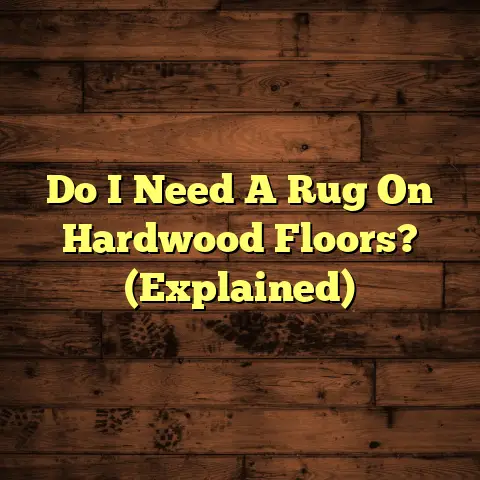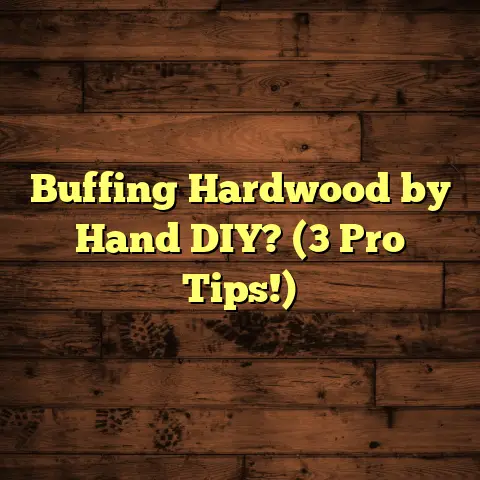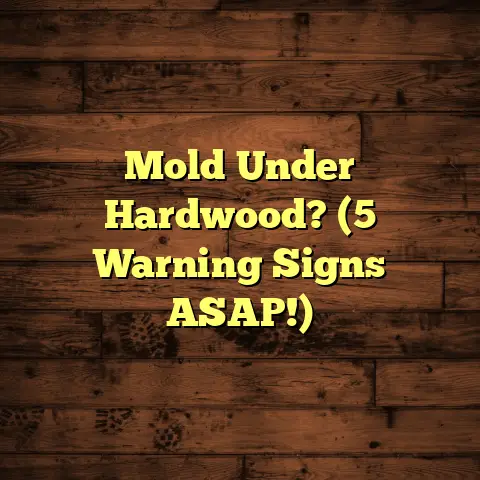Ideal Temp for Vinyl: Don’t Void This! (5 Warranty Risks)
And one thing I see way too often is folks getting burned because they didn’t pay attention to the temperature when it came to their vinyl flooring.
Listen, that beautiful vinyl you just had installed? It’s an investment. And like any investment, you need to protect it. Ignoring the temperature guidelines can lead to a world of trouble, and I’m talking voided warranty trouble.
That’s right, you could be stuck footing the bill for repairs or even a complete replacement simply because you didn’t keep your floor within the recommended temperature range.
So, let’s dive into this. I’m going to walk you through everything you need to know about keeping your vinyl happy and your warranty intact. We’ll cover the types of vinyl, the ideal temperature range, and, most importantly, the five warranty risks you absolutely need to avoid.
Trust me, spending a little time understanding this now can save you a ton of headaches (and money) down the road. Ready? Let’s get started!
Section 1: Understanding Vinyl Flooring and
Its Composition
Okay, so vinyl flooring. It’s everywhere, right? From kitchens to basements, it’s a popular choice for its durability, water resistance, and, of course, the fact that it looks pretty darn good these days.
But not all vinyl is created equal. Let’s break down the main types you’ll encounter:
-
Luxury Vinyl Plank (LVP): This stuff is designed to mimic the look of real hardwood. It comes in planks, and it’s usually thicker and more durable than other types of vinyl.
-
Luxury Vinyl Tile (LVT): Similar to LVP, but in tile form. Think stone or ceramic looks. Great for bathrooms and kitchens.
-
Sheet Vinyl: This is your classic vinyl flooring. It comes in large rolls, making it virtually seamless. It’s often the most budget-friendly option.
Now, what’s it all made of? Essentially, vinyl flooring is constructed from layers of synthetic materials, primarily PVC (polyvinyl chloride).
These layers often include:
-
A Wear Layer: This is the top layer that protects the floor from scratches, stains, and wear. The thicker the wear layer, the more durable the floor.
-
A Print Layer: This is where the design comes from. It’s a high-resolution image that’s printed onto the vinyl.
-
A Core Layer: This provides the floor with its stability and thickness.
-
A Backing Layer: This is the bottom layer that provides cushioning and helps to adhere the floor to the subfloor.
So, how does temperature affect all these layers? Well, PVC is a thermoplastic, which means it expands when heated and contracts when cooled. Think about what happens to a plastic water bottle left in a hot car – it warps, right? The same thing can happen to your vinyl floor, just on a slower, less dramatic scale.
Extreme temperatures can cause the vinyl to become brittle and crack, or it can cause the adhesive to fail, leading to lifting and bubbling. And let’s not forget about fading! Prolonged exposure to direct sunlight can cause the print layer to fade, leaving your floor looking dull and worn.
Even during the manufacturing process, temperature is critical. Too much heat during production can lead to inconsistencies in the vinyl, making it more prone to problems later on. That’s why reputable manufacturers have strict temperature controls in place.
Think of it like baking a cake. If your oven temperature is off, the cake won’t rise properly or it will burn. Same principle applies to vinyl flooring!
Section 2: The Ideal Temperature Range for
Vinyl Flooring
Alright, let’s get down to brass tacks. What’s the magic temperature range we’re shooting for?
Generally speaking, the ideal temperature range for both installing and maintaining vinyl flooring is between 65°F and 85°F (18°C and 29°C).
Now, why this range? Well, it’s all about minimizing expansion and contraction. Within this range, the vinyl will remain relatively stable, reducing the risk of problems.
But what happens outside this range? Let’s take a look:
-
High Temperatures (Above 85°F): When vinyl gets too hot, it expands. This expansion can cause the floor to buckle, warp, or even lift away from the subfloor. I’ve seen cases where entire floors have become completely unglued due to excessive heat. Not fun!
-
Low Temperatures (Below 65°F): When vinyl gets too cold, it contracts. This contraction can put stress on the seams, leading to cracks and gaps. It can also make the vinyl more brittle and prone to damage.
Think of it like a rubber band. If you stretch it too much (high temperature), it loses its elasticity and can eventually snap. If you freeze it (low temperature), it becomes stiff and brittle and can also break easily.
Here’s a table to illustrate the potential consequences:
| Temperature | Potential Consequences |
|---|---|
| Above 85°F (29°C) | Buckling, warping, adhesive failure, expansion issues |
| Below 65°F (18°C) | Cracking, gaps, brittleness, contraction issues |
It’s also important to consider the temperature of the subfloor. If the subfloor is significantly colder or hotter than the vinyl, it can cause problems.
For example, if you’re installing vinyl over a concrete subfloor in a basement, make sure the concrete is at least 65°F before you start. Otherwise, the vinyl could contract and crack as it adjusts to the colder temperature.
I remember one job where the homeowner insisted on installing vinyl in their sunroom in the middle of summer. The temperature in that room was easily over 90°F. I warned them that it wasn’t a good idea, but they wouldn’t listen. Sure enough, within a few weeks, the floor started to buckle and warp. They ended up having to replace the entire thing.
The moral of the story? Don’t ignore the temperature! It’s a crucial factor in the long-term performance of your vinyl floor.
Section 3: Five Warranty Risks Associated with
Improper Temperature
Okay, so we know that temperature is important. But what are the specific warranty risks you need to be aware of? Let’s break it down:
Risk 1: Installation Issues
This is a big one. Most vinyl flooring warranties require that the flooring be installed according to the manufacturer’s instructions. And guess what? Those instructions almost always include specific temperature requirements.
If you install vinyl in a room that’s too hot or too cold, the adhesive may not bond properly. This can lead to a whole host of problems, including:
-
Lifting: The edges of the vinyl may start to lift up, creating a tripping hazard and making the floor look unsightly.
-
Bubbling: Air pockets can form under the vinyl, creating bubbles that can pop and damage the floor.
-
Misalignment: The planks or tiles may not line up properly, creating gaps and uneven surfaces.
I’ve seen installers try to rush jobs in extreme temperatures, and it always ends in disaster. The adhesive just doesn’t have a chance to cure properly, and the floor is doomed from the start.
To avoid this, make sure you acclimate the vinyl to the room’s temperature for at least 48 hours before installation. This allows the vinyl to expand or contract to its natural size, ensuring a proper fit.
Also, use the correct adhesive for the type of vinyl you’re installing and follow the manufacturer’s instructions to the letter. Don’t cut corners!
Risk 2: Material Damage
Extreme temperatures can cause irreversible damage to the vinyl itself. As we discussed earlier, high temperatures can cause the vinyl to expand and warp, while low temperatures can cause it to become brittle and crack.
Here are some specific examples:
-
Cracking: Cold temperatures can make the vinyl more susceptible to cracking, especially in areas that experience heavy foot traffic.
-
Tearing: If the vinyl is stretched or stressed due to expansion, it can tear or rip, especially around seams and edges.
-
Delamination: The layers of the vinyl can separate, causing the floor to peel or flake.
These types of damage are almost always excluded from warranty coverage. The manufacturer will argue that the damage was caused by improper environmental conditions, not a defect in the flooring itself.
I had a client who installed vinyl in their garage. They didn’t realize that the garage temperature could fluctuate dramatically, especially in the winter. The vinyl ended up cracking and tearing within a few months. They tried to file a warranty claim, but it was denied because the manufacturer clearly stated that the warranty didn’t cover damage caused by extreme temperatures.
Risk 3: Aesthetic Degradation
Even if extreme temperatures don’t cause structural damage to the vinyl, they can still affect its appearance. Prolonged exposure to inappropriate temperatures can cause:
-
Discoloration: Direct sunlight and high temperatures can cause the vinyl to fade or change color.
-
Fading: The print layer can fade over time, making the floor look dull and worn.
-
Gloss Changes: The surface of the vinyl can become duller or more reflective, depending on the temperature.
These aesthetic issues may not seem like a big deal, but they can significantly detract from the overall look of your floor. And guess what? Most warranties don’t cover aesthetic issues caused by improper environmental conditions.
I’ve seen countless vinyl floors that have faded and discolored due to sun exposure. It’s a shame, because with a little bit of preventative care, it could have been avoided.
Risk 4: Subfloor Complications
The subfloor is the foundation of your vinyl floor. If the subfloor is not properly prepared or if it experiences significant temperature fluctuations, it can cause problems for the vinyl.
Here are some potential subfloor complications:
-
Moisture: Temperature fluctuations can cause moisture to condense on the subfloor, leading to mold growth and adhesive failure.
-
Expansion and Contraction: The subfloor itself can expand and contract with temperature changes, putting stress on the vinyl.
-
Cracking: Concrete subfloors can crack due to temperature changes, creating uneven surfaces that can damage the vinyl.
Most vinyl flooring warranties require that the subfloor be properly prepared before installation. This includes ensuring that it’s clean, level, and dry. If the subfloor is not up to par, the warranty may be voided.
I always recommend testing the moisture content of the subfloor before installing vinyl. If the moisture level is too high, you’ll need to take steps to dry it out before proceeding.
Risk 5: Moisture Issues
We’ve touched on moisture a few times already, but it’s worth emphasizing. Temperature and moisture are closely related, and improper temperature control can lead to moisture problems that can void your warranty.
Here’s how:
-
Condensation: When warm, moist air comes into contact with a cold surface, condensation can form. This moisture can seep under the vinyl and cause mold growth and adhesive failure.
-
Humidity: High humidity levels can create a breeding ground for mold and mildew, which can damage the vinyl and the subfloor.
-
Water Leaks: Temperature fluctuations can exacerbate existing water leaks, leading to more extensive damage.
Most vinyl flooring warranties exclude damage caused by moisture. So, it’s crucial to keep your floor dry and to control the humidity levels in your home.
I always recommend using a dehumidifier in basements and other areas that are prone to moisture. It’s also a good idea to regularly inspect your floor for signs of water damage, such as discoloration, mold, or mildew.
Section 4: Best Practices for Maintaining Ideal
Temperatures
Okay, so we know the risks. Now, let’s talk about how to avoid them. Here are some best practices for maintaining the ideal temperature for your vinyl flooring:
-
Use Your HVAC System: This is the most obvious one, but it’s worth mentioning. Make sure your HVAC system is working properly and that it’s set to a comfortable temperature.
-
Invest in a Dehumidifier: As we discussed earlier, dehumidifiers are essential for controlling humidity levels, especially in basements and other areas that are prone to moisture.
-
Proper Insulation: Good insulation can help to maintain a consistent temperature in your home, reducing the risk of extreme temperature fluctuations.
-
Use Window Coverings: Curtains, blinds, and shades can help to block out direct sunlight, preventing the vinyl from overheating.
-
Avoid Direct Heat Sources: Don’t place space heaters or other direct heat sources too close to the vinyl. This can cause localized overheating and damage.
-
Monitor Temperature and Humidity: Use a thermometer and hygrometer to monitor the temperature and humidity levels in your home. This will help you to identify potential problems early on.
-
Acclimate Before Installation: This is crucial. Allow the vinyl to acclimate to the room’s temperature for at least 48 hours before installation.
-
Communicate with Your Installer: Talk to your installer about the temperature requirements for the vinyl you’re installing. They can provide valuable advice and guidance.
I always tell my clients to think of their vinyl floor as a living thing. It needs to be cared for and protected from extreme conditions. By following these best practices, you can help to ensure that your vinyl floor stays beautiful and durable for years to come.
Section 5: Conclusion
Alright, we’ve covered a lot of ground here. Let’s recap the key takeaways:
-
Temperature Matters: Maintaining the ideal temperature range (65°F to 85°F) is crucial for the long-term performance of your vinyl flooring.
-
Warranty Risks are Real: Ignoring temperature guidelines can void your warranty, leaving you stuck footing the bill for repairs or replacements.
-
Prevention is Key: By following best practices for temperature control, you can avoid costly problems and keep your vinyl floor looking its best.
I know it might seem like a lot to remember, but trust me, it’s worth the effort. Spending a little time and attention on temperature control can save you a ton of headaches and money down the road.
Think of it as an investment in your investment. You’ve already spent money on your beautiful vinyl floor. Now, take the necessary steps to protect it and ensure that it lasts for years to come.
Don’t be afraid to ask questions! If you’re not sure about something, talk to your installer, your flooring supplier, or even the manufacturer. They’re there to help you.
And remember, I’m always here to help too! If you have any questions or concerns, feel free to reach out. I’m passionate about flooring, and I want to help you make the best decisions for your home.
So, go forth and conquer the world of vinyl flooring! With a little bit of knowledge and effort, you can keep your floor happy, your warranty intact, and your home looking beautiful for years to come.





